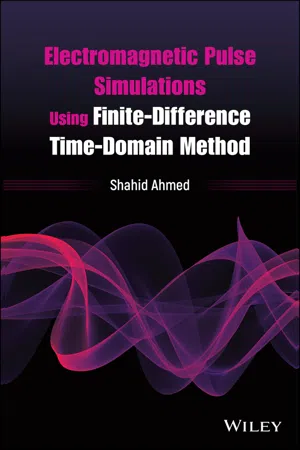
Electromagnetic Pulse Simulations Using Finite-Difference Time-Domain Method
- English
- ePUB (mobile friendly)
- Available on iOS & Android
Electromagnetic Pulse Simulations Using Finite-Difference Time-Domain Method
About this book
Electromagnetic Pulse Simulations Using Finite-Difference Time-Domain Method
Discover the utility of the FDTD approach to solving electromagnetic problems with this powerful new resource
Electromagnetic Pulse Simulations Using Finite-Difference Time-Domain Method delivers a comprehensive overview of the generation and propagation of ultra-wideband electromagnetic pulses. The book provides a broad cross-section of studies of electromagnetic waves and their propagation in free space, dielectric media, complex media, and within guiding structures, like waveguide lines, transmission lines, and antennae.
The distinguished author offers readers a fresh new approach for analyzing electromagnetic modes for pulsed electromagnetic systems designed to improve the reader's understanding of the electromagnetic modes responsible for radiating far-fields. The book also provides a wide variety of computer programs, data analysis techniques, and visualization tools with state-of-the-art packages in MATLAB ® and Octave.
Following an introduction and clarification of basic electromagnetics and the frequency and time domain approach, the book delivers explanations of different numerical methods frequently used in computational electromagnetics and the necessity for the time domain treatment. In addition to a discussion of the Finite-difference Time-domain (FDTD) approach, readers will also enjoy:
- A thorough introduction to electromagnetic pulses (EMPs) and basic electromagnetics, including common applications of electromagnetics and EMP coupling and its effects
- An exploration of time and frequency domain analysis in electromagnetics, including Maxwell's equations and their practical implications
- A discussion of electromagnetic waves and propagation, including waves in free space, dielectric mediums, complex mediums, and guiding structures
- A treatment of computational electromagnetics, including an explanation of why we need modeling and simulations
Perfect for undergraduate and graduate students taking courses in physics and electrical and electronic engineering, Electromagnetic Pulse Simulations Using Finite-Difference Time-Domain Method will also earn a place in the libraries of scientists and engineers working in electromagnetic research, RF and microwave design, and electromagnetic interference.
Frequently asked questions
- Essential is ideal for learners and professionals who enjoy exploring a wide range of subjects. Access the Essential Library with 800,000+ trusted titles and best-sellers across business, personal growth, and the humanities. Includes unlimited reading time and Standard Read Aloud voice.
- Complete: Perfect for advanced learners and researchers needing full, unrestricted access. Unlock 1.4M+ books across hundreds of subjects, including academic and specialized titles. The Complete Plan also includes advanced features like Premium Read Aloud and Research Assistant.
Please note we cannot support devices running on iOS 13 and Android 7 or earlier. Learn more about using the app.
Information
1
Electromagnetic Pulse
1.1 Sources of EMP










1.2 EMP Coupling and its Effects
1.3 EMP Simulators



1.4 Review of Earlier Work
Table of contents
- Cover
- Table of Contents
- Title Page
- Copyright
- Dedication
- Acknowledgments
- Preface
- 1 Electromagnetic Pulse
- 2 Time and Frequency Domain Analysis
- 3 Simulations Using FDTD Method
- 4 Electromagnetic Pulse in Free Space and Material Media
- 5 Simulation of Capacitor Bank
- 6 Bounded Wave Simulator for Electromagnetic Pulses
- 7 Electromagnetic Modes Inside Bounded Wave Simulators
- 8 Parametric Study of Radiation Leakage from a Bounded‐Wave Simulator
- 9 Modal Perspective of Radiation Leakage from a Bounded‐Wave Simulator
- 10 Spatial Mode Filter for Reducing Radiation Leakage
- 11 EMP Interaction with Biological Tissues
- 12 FDTD Computer Program
- References
- Index
- End User License Agreement